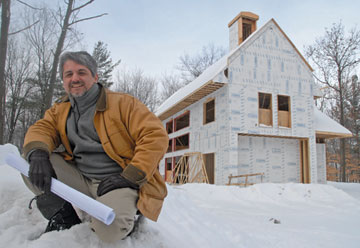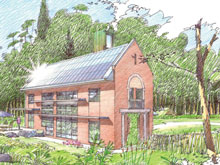
Montréal ZERO
Unlike the other Equilibrium projects, the objective of team Montréal ZERO, led by Sevag Pogharian Design, was to transcend the goal of a net zero energy house. Thus, Alstonvale Net Zero House (ANZH) was meant to demonstrate the attainability of a higher goal, a net zero energy lifestyle. Implicit in this notion of a net zero energy lifestyle is Pogharian’s core philosophy: his belief that a house is not just a home. If designed intelligently, a house can be the enabling backbone that supports a household’s needs for shelter, mobility, and food solely through a reliance on solar energy and without any associated GHG emissions.
The methodology to get to net zero is very clear, starting with reducing the energy consumption of the building. “This is done in three ways,” Pogharian said. “At the outset, it is achieved by integrating passive solar, building an excellent building envelope, and reducing the internal demand loads of the building. After reducing the energy requirements of the building, you think of ways to generate enough energy for the house. The first thing you generate is heat and the last, more complex thing, is power. Building the package is very challenging.”
Pogharian has learned this lesson the hard way. A graduate from the school of architecture at McGill University, with a Master of Science in Architecture Studies from MIT (focusing on housing policy and finance), he is one of those architects who could never be satisfied with just “drawing the plans.” He also wanted…needed… to build. In the mid 1990s, he opened Sevag Pogharian Design.
Learning Curves
“I understood that to be relevant in housing you have to be more vertically integrated,” Pogharian said.
“To get my feet wet, I first did some renovation jobs in the building process as a design builder, doing my own jobs. From the beginning, I subcontracted all the work. This approach seems to work for my more complex, custom-build type of houses. The first big lesson I learned when starting to build was how little I knew about the process. You just don’t learn this in the short four years in architecture school. Construction is all about the process.”
Pogharian admits the transition from architect to residential home builder was a hard boundary to break, but the end result is a far better understanding of the process, the ability to improve and hone in on the final details, the end results. “I’ve learned a lot about how buildings are built and, if you don’t have this kind of intimate knowledge, there isn’t any way you will make a change in the process. As a builder, you can see where and why quality flies out the window, why you cannot rush the process.
As for an energy and environmental awareness, Pogharian says that the most important elements don’t involve technology, although passive solar design is essential. “Passive solar as a way of reducing the energy consumption of a building makes such a huge impact. When I first saw the Concordia University simulations of the impact of passive solar heat gain in the winter, my jaw dropped. It became clear to me that this is the way to go.”
 |
A Master Plan
The ANZH is aggressively passive and integrates a lot of passive solar ideology, both on the heating and the cooling cycles. “None of the techniques are new... They’ve been around for a long time,” Pogharian says. “I feel that integrating passive solar should be obligatory and integrated into everything we are building now. The sun is here for us to take advantage of now. What we have to do is change our thinking and lifestyle.”
Pogharian is now working on a master plan of a net zero energy lifestyle neighbourhood for Carbecco development. The plan calls for 400 to 500 housing units in Vaudreuil, west of Montreal, under the name cité ZERO Vaudreuil. The challenge is to build a neighbourhood on Pogharian’s core principles. All the elements of the stand-alone ANZH will be incorporated, but he won’t stop there. “Neighbourhoods can do a lot a more. Almost everything will be directed to sun, with many dead end streets, a pedestrian’s network, integrated electric vehicle charging, and many other energy saving initiatives.
“It is evident to me that this kind of project would require zero sacrifice in comfort. The main message I have tried to convey with this project is that we can live a very comfortable and elegant life, while consuming a fraction of the energy and water we do now. We will still have all the important things in life, such as freedom of speech, and great quality of life. But driving huge cars and living in oversized houses, those days are gone. We need to move away from the consumption side and start acting responsibly as world citizens.
For more information, visit www.spd.ca


